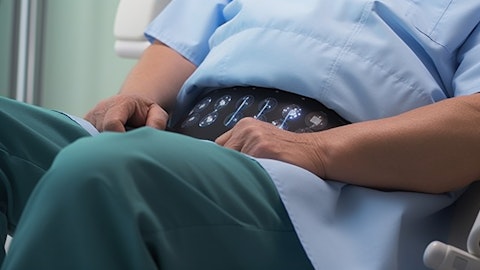Jared Oasheim: Yes. Good question. So as we set the guide for 2024, we’re looking at the two different components, right, the ASPs and the costs. First, on the ASPs, we’ve mentioned that the guide is assuming a reduction in that overall U.S. Heart Failure ASP from $31,000 down to closer to that $29,500 at the midpoint. So that can have an impact on the overall gross margin results for ’24. And then the second component is the cost. We’ve talked a lot about as we see the volume increase, we shouldn’t see an overall trend of seeing that cost come down. So as we see production go up, the cost should come down. However, if we continue to buy components for these devices, we’re going to have to go out and negotiate new contracts with new vendors at different times.
And at those points in time, we may see a price increase for the components themselves, not necessarily as much focused on the labor and overhead pieces of that. So both of those factored into our decision to guide us at the 83% to 84% for ’24.
Bill Plovanic: Okay. Great. Thanks for taking my questions.
Operator: Our next question comes from the line of Alex Nowak with Craig-Hallum. Please proceed with your question.
Alex Nowak: Okay, great. Good afternoon, everyone. Now with BeAT-HF done, FDA approval in hand, that’s all wrapped up. Just holistically, where is Barostim going to go next? There’s a ton of potential, as you know, in the baroreceptor stimulation. Does it make sense to spend clinical study dollars to go deeper into the left side of indication, the increase of the ejection fraction or change in the BNP requirements? Or does it make more sense to really go after a completely new indication?
Nadim Yared: Alex, excellent question. So we spoke in the past that we believe from the mechanism of action and some previous experiment that the device could have applicability beyond heart failure, particularly we spoke about hypertension, chronic kidney disease and arrhythmias. And in the past, FDA has granted us, based on previous clinical data that we submitted to FDA two device — breakthrough device designation, BDD, one in heart failure with preserved ejection fraction and one in resistant hypertension. So when we considered both of those two indications, there’s just a hypertension and HFpEF, it was probably or likely that one of these two will be the second indication we go after. Then when we got invited to be one of the 15 initial pilots that FDA started this year with a new program called the TAP, Total Life Cycle Advisory program, T-A-P, that was limited only to breakthrough device designated indications for new products.
We started working with FDA about the HFpEF indication. So this is the heart failure indication with ejection fraction above 35%. For us, it would make more sense to go after this indication for multiple reasons. One of them is the synergy in the sales and marketing efforts. The physicians will be the same. The call points will be the same. Even some of the direct-to-consumer marketing campaign would be the same. Most of the education will be the same and so forth. Is it a new indication? I would say, yes, because those two diseases are different. And if we are approved in EF above 35%, that would significantly and substantially increase the total addressable market of our therapy. So while we are excited about this opportunity, we are in the early phase of the design of the study.
Part of the TAP program is the requirement to collect stakeholder input before we start the enrollment of the trial. So we need to collect it, but not only from the regulators and physicians, but also from patients, payers, guideline committees and so forth, and we are in this process. We actually had a very constructive meeting last week during the Heart Failure Collaboratory with regulators, payers, patients and key opinion leaders and medical societies as well in one single meeting. So this is where we are right now. On the question of when do we start this program? It’s early to know how long it will take to design or finalize the design of the trial? And then the second question will be the question of spending that Jared was talking about for the previous question that you got.
Alex Nowak: Okay. That’s extremely helpful. And Nadim, obviously, congrats on the retirement and getting to bear from where it is today. You’re obviously on the board. In your conversation with them about the transition that will take place here. Is there still — is there a plan for you to remain on the board? Any views you can kind of give there?
Nadim Yared: Alex, thanks for asking the question. So listen, at the end of the day, I will do whatever is needed in here to ensure that CVRx has the best and smoothest transition possible between me and the next CEO. So yes, I help the board in terms of the search. We meet with the search committee on a daily basis to identify and look at all of the candidates, internal and external. And whether I stay on the board or not is not the point. The question is, what is the most effective way for me to be helpful, not only during the transition, but also after this transition depending on what the board and the new CEO will need from me. Listen, I — this is my baby. I’ve been here 17 years, I’m not going to drop it one day and forget about it.
So it’s in my best interest to ensure that I dedicate the time needed and you have to ensure as smooth as possible transition. And whichever form that takes, I really — it’s immaterial, whatever the new CEO and the board want we do, I will do.
Alex Nowak: That’s good to hear. And then maybe just a quick question for Jared. Whenever we get a new code, hospitals always go through a transition process. For the Q1 guidance, can we assume that there’s a little bit of conservatism built in for hospitals going through that transition where they might be a little more hesitant to buy just because they got to figure out the reimbursement dynamics again?


